The Glen-L Squirt is a small boat with big ideas. Only 10′ long and with room for just two people, it’s limited in what it can do, but it has the undeniable good looks of a mid-20th-century runabout. The Glen-L website acknowledges the small size but sees it, and the lightweight construction, as a strength, stating that “this little boat will move out quicker with less horsepower than the average production boat…” and concludes that the Squirt is often a “first boat” for the “young at heart,” and “a good boat for the younger set.”
For Bill Bains of Port Angeles, Washington, the Squirt brings back memories of teenage adventures. “When I was a kid in California,” he says, “a friend’s father built a small plywood motorboat, a little smaller than a Squirt. It was painted black and had a 20-hp Mercury, which we could sometimes get started. I had a 1959 Ford Ranchero and a home-built trailer with Model-T wheels. We’d take the boat out to Lake Havasu on the Colorado River and motor around just as fast as we could go. It was a hoot. I remember the weather being about 110 degrees and we’d spend as much time sitting in the water as riding in the boat.”
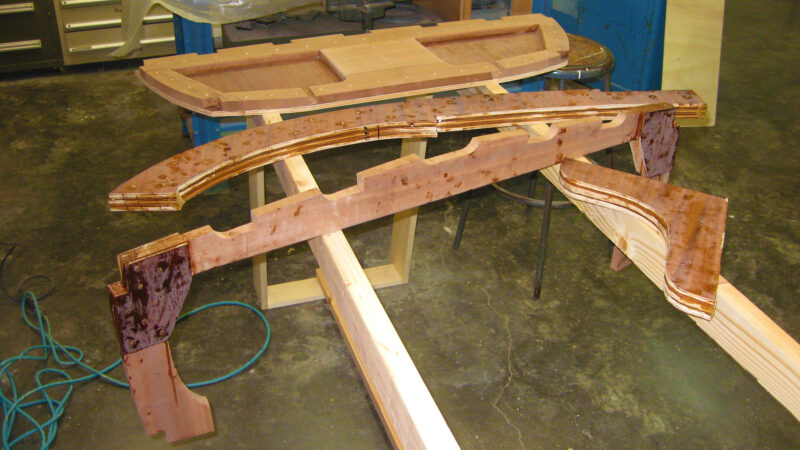 Bill Bains
Bill BainsBuilding the stem, breasthook, and frame members was straightforward, says Bill, thanks to the full-sized templates supplied by Glen-L.
In 1970, after college, Bill took a job at Sierra Middle School in Riverside, California, teaching woodworking to 7th and 8th graders. Seven years later he moved to the high school to teach woodworking and architectural drawing. He stayed for 27 years. He recalls that in 1974 he and the metal-shop teacher would often eat lunch together and the conversation would turn to boats. “We were always talking about getting a sailboat and taking it all over the country and around the world. But I could never afford a sailboat big enough.” Instead, Bill bought a used Catalina 22, a trailerable ’glass pocket cruiser, which he sailed from Los Angeles across to Catalina Island or out of Dana Point, a city farther south, and sometimes on Lake Perris on the outskirts of Riverside.
When Bill retired in 2004, he sold the Catalina and moved with his wife, Robin, to Port Angeles, Washington. He’d heard that the salmon fishing there was good, so he bought a 17′ fiberglass cuddy-cabin runabout with a 90-hp Evinrude and a 9.9-hp kicker. “It was a really good fishing boat. A friend of mine had one just like it. He also had a motorcycle and said I should get one of those, too. I’ve ridden motorbikes my whole life, but I couldn’t afford the boat and the bike. In the end we realized we didn’t need two boats, so I sold mine and bought a bike. Then he decided he didn’t want to fish anymore, so he sold his boat, and that was that—I had a nice bike but no boat!”
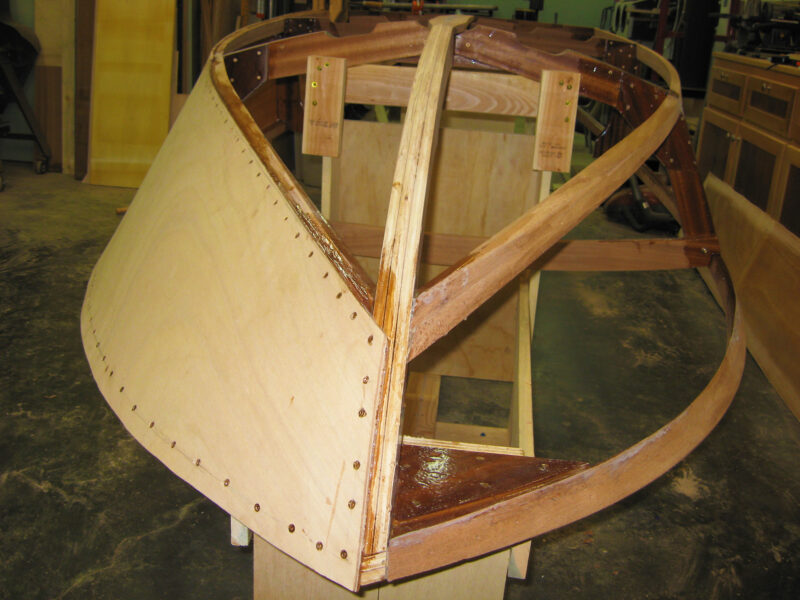 Bill Bains
Bill BainsWith the backbone, chines, and deck frame set up, the plywood side panels were screwed and glued in place. Bill struggled to bend the chines, breaking two before setting up a steambox and softening up the third and fourth so they would take the bend.
With time on his hands, Bill decided to build his own boat and started looking for something suitable. His first requirement was that the project must fit in his shop. “The North Olympic Peninsula here in Washington is cold for a good part of the year and I like to stay warm.” Next, it had to be a project for which he had the appropriate skills. “I’ve been a woodworker most of my life, but I’ve never built a boat.”
During his online searching, Bill came upon the Glen-L website and its many designs specifically aimed at the amateur builder. He was struck by the Zip, a two-seat “deluxe sport runabout in the classic style,” but at 14′ it was too long. Then he saw the Squirt. “I immediately felt that this was the one. It has those classic lines of the early Chris-Crafts, and at only 10′ or 11′ it would fit in the shop. Also, being a small boat built of 1⁄4″ plywood, I figured it wouldn’t cost a fortune to build.”
He ordered the plans.
At over 6′ tall, Bill knew that fitting into the Squirt would be a challenge and so, with Glen L’s approval, he would stretch the boat. “I was aiming for 11′ but somehow ended up with 10′ 8″—an extra 6″ in the cockpit and 2″ in the foredeck. Glen L advised against increasing the beam, so I left that at 4′ 4″.”
The only other departure Bill made from the original design was in the transom. The plans call for a 10-hp engine, but Bill was looking for a bit more power, so he reinforced the transom.
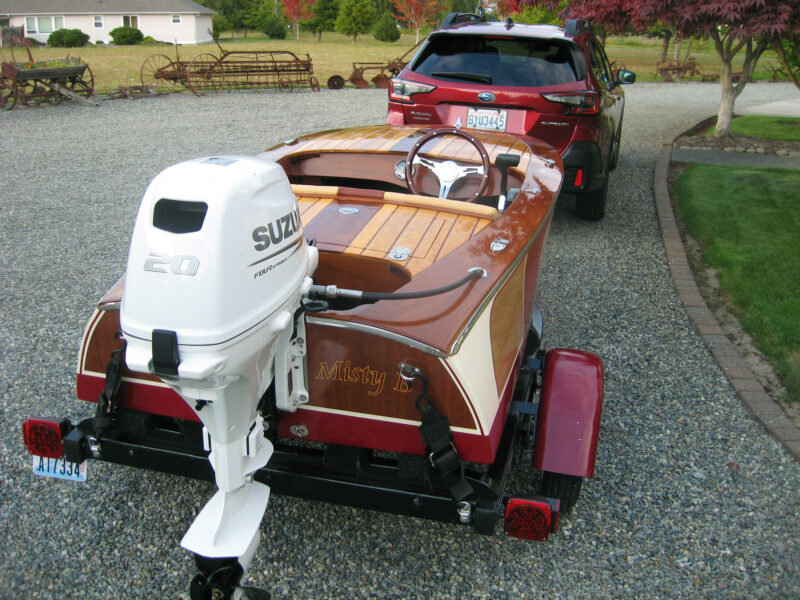 Bill Bains
Bill BainsAll dressed up and ready to go. While the engine may be modern, MISTY B’s aesthetic is pure vintage from the paint scheme to the chromed fittings, the wooden steering wheel, and the faux laid decks. Even the trailer is painted to blend in with the overall theme.
The project, says Bill, was not overly challenging but, despite his lifetime of experience with the tools and materials, there was, he reflects, “a lot of learning. A lot of exercise with assorted planes. A lot of learning how to do boat things.” Among the more taxing aspects was achieving the required bend in the chine log. “I broke two different chines trying to get them where they were supposed to be.” Not to be daunted, Bill created a steambox with a 10′ length of 4″ plastic pipe, a saucepan with a lid, and a Coleman stove. “I fed steam into the pipe and, after about 30 minutes, I took the chine log out and it bent nicely into place.”
He had a similar problem bending the plywood side panels to create the tumblehome in the stern. “I created a plastic-sheeting tent around the back of the boat and boiled water inside the tent. After about half an hour the plywood was pliable enough that I could screw it into place.”
From start to finish, the Squirt was in Bill’s shop for about two-and-a-half years. He took his time, working most afternoons, but only for an hour or two at a time, and always alone. “I’m a bit of a loner when it comes to work,” he says. “I like to do what I like to do when I like to do it, and I enjoy learning and figuring things out. Fairing the frames was one of the harder parts, and there was a bit of a learning curve to the process of fiberglassing with epoxy resin. And when it cured, the final sanding took a very long time. But it was all really satisfying.”
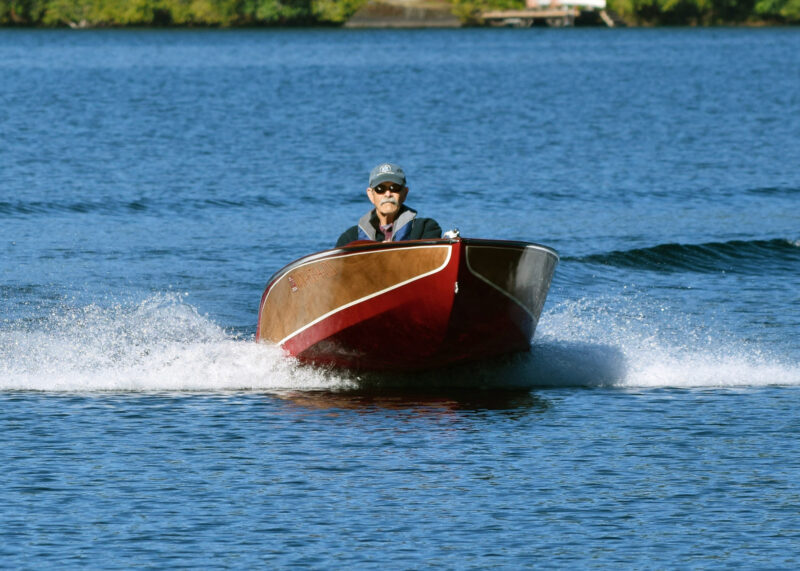 Peter Harrington
Peter HarringtonMISTY B’s paint scheme was, says Bill, heavily influenced by Art Atkinson’s Squirt (Small Boats, June 2016). It was a new challenge for Bill but, he says, it was very satisfying to see it all come together.
Bill had always known that he wanted more than the recommended 10-hp outboard, and that he wanted an engine that fit the Squirt’s aesthetic. He went in search of a vintage two-stroke outboard. There was an outboard-motor repair shop near his home, and Bill stopped by one day. The owner showed him a pile of old engines out back. “It must have been 20′ × 20′ and about 4′ or 5′ high,” says Bill. He told the mechanic he was looking for an antique Johnson or Mercury around 20 hp. “We wandered about a bit, and then he said, ‘I think over by that tree there’s something like that.’ Sure enough, there was an old Johnson. It was only 10 hp, but it looked like it was all there, so I paid him $100 and took it home.” Bill laughs, “I shouldn’t have done that. When I started playing with it, I realized it had no spark and not much compression. I spent another $150 on parts and then put it aside—I was still working on the boat.”
He decided to cut his losses and look for something else. “I found a 1969, 20-hp Mercury for sale. It had a red stripe around a black cover. It looked really neat. I paid way too much for that one, too. It did have a spark and some compression, but I couldn’t get it to run.”
Bill started taking the engine apart and for a while things went well, until, partway through the restoration, he got cold feet. “I had this thought one day: I’m not an outboard mechanic. I’m going to be stuck in the middle of Lake Crescent one day and I’m going to be pulling on the rope of the motor and I’m not going to be able to get it started.” The thought wouldn’t leave him and the more the scenario haunted him, the more uncertain he became, until “I did what I should have done at the beginning. I bought a new motor. A 20-hp four-stroke Suzuki with electric start and electric trim tilt.”
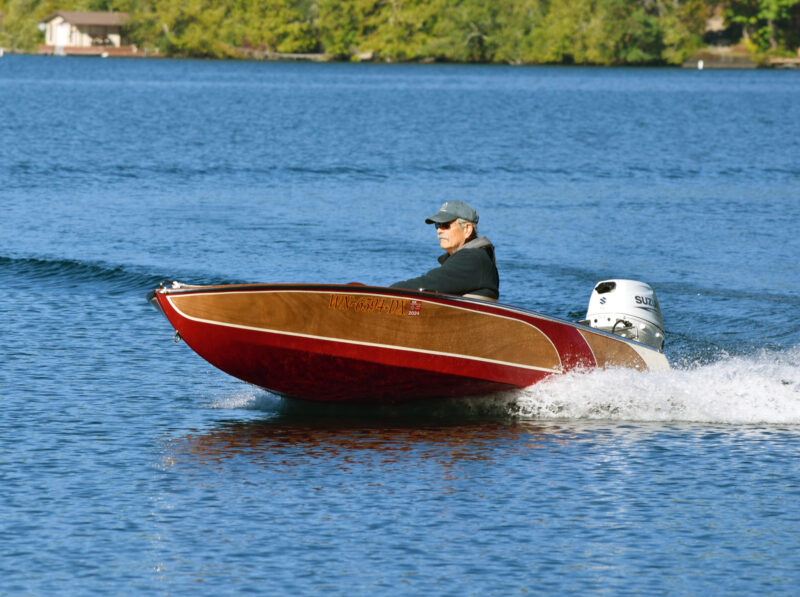 Peter Harrington
Peter HarringtonThe new 4-stroke 20-hp outboard is heavier than the suggested vintage 10-hp, but after placing additional ballast up forward, Bill has corrected the trim and MISTY B now handles well at all speeds and especially through turns.
Bill finished his Squirt late summer 2023, named it MISTY B after the family dog, and launched on Lake Sutherland about 12 miles to the west of Port Angeles. On his first outing he discovered his one substantial mistake. The larger motor, combined with the battery and gas tank, both located in the stern, adversely affected the boat’s trim. Not only did it sit stern-heavy, but at speed it tended to porpoise. With hindsight he realized he should have placed the battery forward of the cockpit, but it was too late to move it. “It’s impossible to get up in the bows to do anything constructive. I did manage to get a 25-lb bag of shot up there, though, and she now rides nicely at about 26 mph, nice and flat.”
Bill went out in MISTY B three times in 2023. His friend Peter, who owns a 15′ Rascal outboard skiff, came with him as support vessel and also took a turn at the wheel. “We never went out together,” says Bill, “but it was fun to see someone else take it out. It’s a hoot to drive.”
As for building another boat, Bill is pretty sure that won’t happen. “It was a lot of fun, but I think it was a one-off. I’ve got to come up with something else, but it won’t be a boat. I don’t need another boat.” Despite that, in September 2023, Bill exhibited MISTY B at the Wooden Boat Festival in Port Townsend. He couldn’t believe all the compliments they received. “One man came by and said he’d looked at all 300 boats at the festival, and he liked mine the best. That made me pretty happy.”![]()
Jenny Bennett is managing editor of Small Boats.
Do you have a boat with an interesting story? Please email us. We’d like to hear about it and share it with other Small Boats readers.
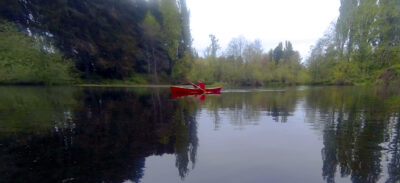

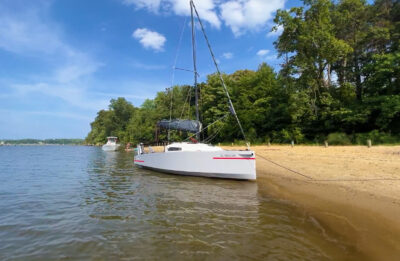
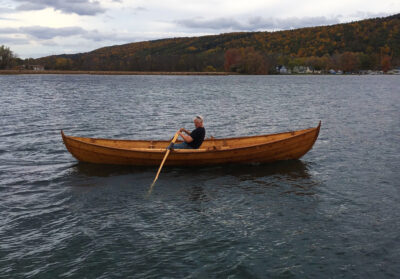
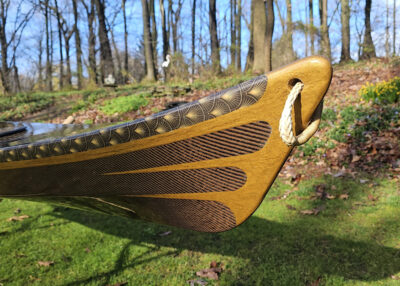
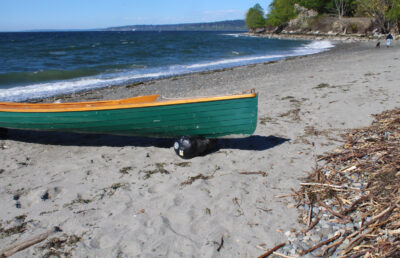
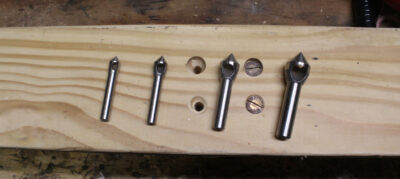
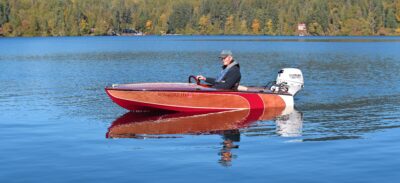
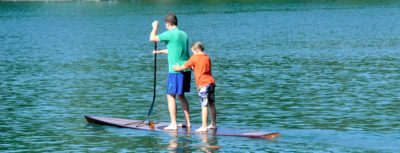
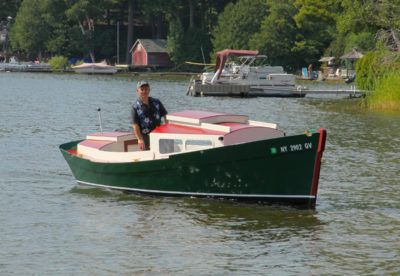
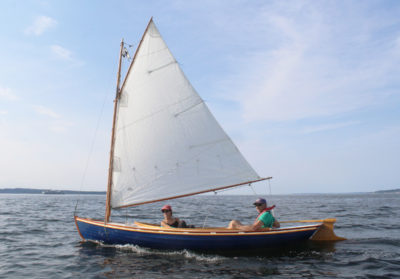
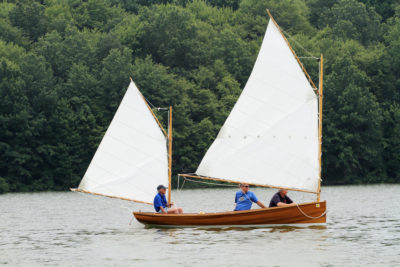
Thanks for the credit on the paint scheme.
Art Atkinson
I think yours came out better than mine. That being said, I liked the fact that the scheme covered the scarf joint.
Art, your boat was my inspiration during my entire build and I had its picture taped to my wall the whole time. Thanks for keeping me on track and excited to get it done.
I have published volume one and two of Americans In Their Own Words but find the way you balance between his words and your own a better overall approach.. Thanks so much. My own 86 years makes getting in and out of small boats a real challenge however .
Picture Thanks Nicholas, I’m glad you enjoyed it.
Need more non-sail type articles….a lot of us don’t have time for snail sail….
Im blown away by your article. Our projects sort of mirrored each other. I found a derelict boat in a tow yard 9 years ago. It was supposed to be a group project with friends, but things did not work out as planned. I brought the boat home 3 years ago to complete the project before it would go to the dumpster…My wife was not happy… I searched the internet for a 20 Hp motor and located a 1970 Mercury short shaft. It had great compression, but I could not start it being in my 60s. I injured my arm trying to start it. After a trip to a wooden boat show in Vermont…. I identified the boat…. Turns out the boat is a 1954 13′ Chris Craft kit boat….. converted to a runabout by the original owner. After much research, sold the Mercury to a collector in Massachusetts.. Purchased a 20 HP Suzuki in white. . Its been in the water 2x so far and does well for its size.
Near the end of last year’s boating season here in Michigan, I repowered my Glen-L Squirt with the Suzuki 20 HP electric start and power trim. I had reached my limits of patience and confidence with keeping the 1956 Mercury Mark 25 in good running condition. The Suzuki’s power trim allows immediate adjustments for the extra weight of the motor or passenger load. Looking forward to this year’s boating season.
I built one of these as well, it attracts a lot of attention wherever I go.
Mine is powered with a 1958 10 HP Johnson which gets it on a plane in a matter of seconds when I’m on my own. With 2 persons it takes slightly longer, roughly 12 seconds.